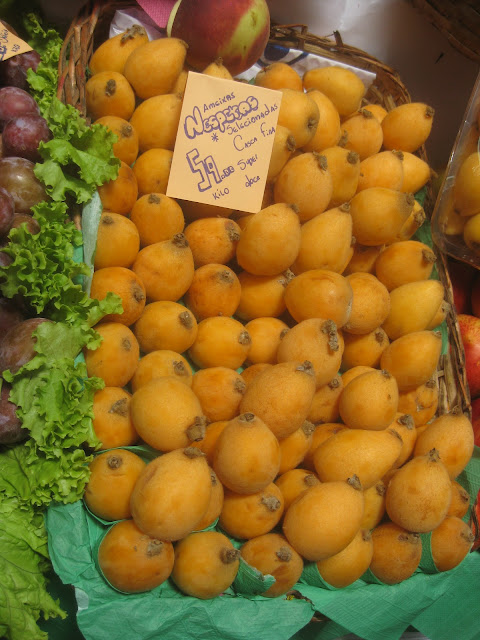 Recently on our visit to Sao Paulo, we stopped at the municipal market and enjoyed the sights and sounds of a fully functioning market. Filled with all kinds of products to tempt your taste buds. Before leaving the market we approached one of the vendors who had a magnificent display of fruits. After explaining I was from the United States, he began giving me samples of some of the fruits from his booth. Many of them I had never seen before and surely had not tasted. It was truly a treat for my taste buds.
Recently on our visit to Sao Paulo, we stopped at the municipal market and enjoyed the sights and sounds of a fully functioning market. Filled with all kinds of products to tempt your taste buds. Before leaving the market we approached one of the vendors who had a magnificent display of fruits. After explaining I was from the United States, he began giving me samples of some of the fruits from his booth. Many of them I had never seen before and surely had not tasted. It was truly a treat for my taste buds.
The first fruit we picked from the baskets was Longan. My original hope was to taste more of Brazil but this fruit is actually imported from Southeast Asia. It really did not look very appetizing from the outside and I wondered to myself if I really wanted to give it a try. Longan is grayish brown in color and has a stem protruding from one end which obviously is where it had been attached to the tree. To get beyond the thin shell you just have to give it a little squeeze and the fruit pops right out. I understand if this process is easy, that is how you tell the fruit is ripe. The Longan fruit has the nickname of "dragon eye" and when we expose the edible part it is obvious why. Once the grayish brown peal is removed the remaining fruit looks like an eyeball and has a slimy texture. There is a black seed on the inside which is hard but can be eaten however I did not eat the seed. My explanation of the Longan would be that it is slimy, sweet, juicy, and succulent. I would definitely purchase these for an afternoon snack if I lived in Sao Paulo. .


The next fruit to taste is primarily from Northeastern Brazil although it can be found in other Central and South American countries. This cherry tomato like fruit is called Siriguela. Although it looks like a cherry tomato that is where the similarities end. Harvested from trees, the little fruit is full of vitamin A, B, and C. So it looks and feels like a tomato but the texture of the meat is more like a grape. The flavor is not like anything I have tasted before as it blends a sweet with an element of sour. I understand the fruit sweetens as it ripens. The note I jotted down about the taste was: honey and grapefruit but not really like that at all.

The yellow with a hint of orange color of the Nesperas fruit catches my eye next. I had not previously seen this fruit in the markets of Brazil and since I am trying new things of course I motion to my fruit expert that this is the next one I want to try. Originally from China, the fruit can be found in many other places around the world including Hawaii. The fruits exterior resembles a pear without the historic shape of a pear although I found out later there is a variety that has the pear shape. Upon taking a bite a sweet but slightly acidic flavor fills my mouth. For me it would best be explained as a mix of peach and citrus with a slight hint of mango. Definitely a flavor I have never encountered before and I continuing eating the whole piece that was cut off for me.
As I look over the selection of fruit I am intrigued by a dark purple fruit on the end of the table and motion the fruit guide to try this next.
The purple mangosteen is imported from Indonesia and that area of the world. Our guide scores the outer layer of the fruit with a knife and gently twists it open to reveal a cluster of white wedges tightly arranged inside. These white wedges are the edible part of the fruit and he extracts one for me to sample. My explanation of the Mangosteen fruit would be that it is quite juicy and smells good. Not sure I have ever tasted a flavor like it, maybe some combination of melon, banana, and green apple in a grape like texture without the skin. To be quite honest it is a great blend of sour and sweet and my attempts to explain the flavors probably fall short. In researching a little on Wikipedia, I find out that this fruit is called "The Queen of Fruits", probably because of a legend that Queen Victoria offered great rewards to anyone who could bring this fruit to her. (there is no historical proof of this legend however)


Of course when you look at the photo of the next fruit, it is no wonder it caught my eyes and they screamed at my tastes buds for a taste. Rabutan is a beautiful red fruit with a spiny shell. The fruit guide grabs a couple and again scores one side of the outer casing. He proceeds to squeeze it open and soon the slightly white but translucent fruit is exposed. He hands it to me and I bring it to my mouth, a mildly acidic yet sweet flavor. I did not jot down good notes on this fruit so will have leave it at that. However, I do remember that I ate both of the sample he opened up for me.


Without direction our fruit guide grabs the next fruit off the display and with a swift movement of his knife cuts the Grenadia or Sweet Grenadilla in half. A variety of the passion fruit which on previous tastes was quite sour, I am hesitant to take a taste. But then again, I am about trying new things and who knows, this may have a different flavor as it is a different passion fruit. The Grenadia grows in regions of South America and other tropical parts of the world. I fill the spoon with the clear gel like meat of the fruit and bring it to my mouth. Expecting the bitter taste, my little taste buds are pleasantly surprised as the flavor of this fruit is quite a bit more sweet. No sour here. The slimy fruit is not my favorite flavor but this type of passion fruit is definitely more pleasing then the ones I have had before.


Of course our visit to the fruit stand would not be complete without a sample of grapes, bananas, strawberries and cherries. I am impressed with the large variety of grapes and bananas. I did not realize there were different varieties and each one had a little different flavor or texture. All the fruits sure pack a punch when it comes to flavor as many are grown locally and picked ripe. I snap a photo with our taste guide, tip him, and we are on our way. Definitively one of my favorite experiences in Sao Paulo.





















































